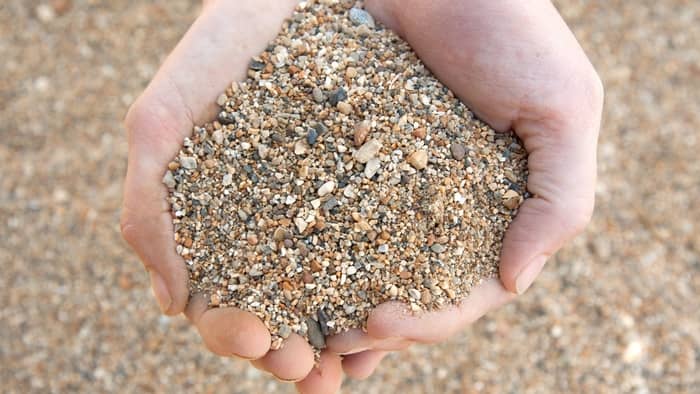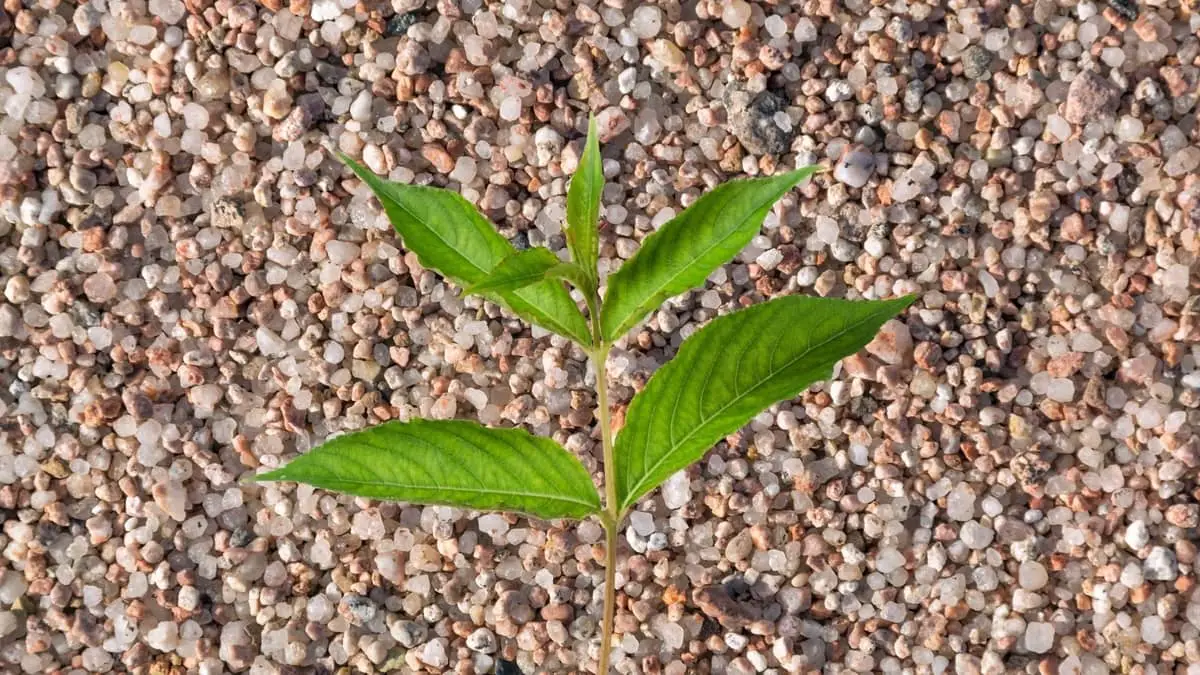Last Updated on March 13, 2023 by Griselda M.
Can you use coarse sand for plants? Yes! In fact, with a bit of work, coarse sand can be some of the most instantly productive soil for growing plants such as squash, potato, and tomatoes! Follow for a few tips I have learned over the years.
Once upon a time, I injured myself and ended up in the hospital for quite a while. The doctor suggested that for rehabilitation, I needed to do weights to help strengthen my hands!! I asked if shoveling coarse river sand was ok, and he said yes. So, every evening for 3 months, I loaded a ton of river sand from an old reservoir and used this to formulate a few raised beds for growing potatoes and other root vegetables.
Have a quick read below to learn more about the benefits of coarse sand for your garden plants.
Types of Soils and Their Characteristics
Soil is made up of different materials, including sand, silt, clay, organic matter, and water. Below, we have individualized them to give you a clearer picture of what each one entails.
Sand
This is a relatively coarse particle-size soil that does not clump together. It drains very well and tends to be quite nutrient-poor as a result. Sandy soils can be fed heavily with organic matter, and manure and mulching can help to retain moisture in the surface layer.
Silt
Silt is a soil type where the particle size is generally a bit finer than sand, but it is still relatively well drained. Silt tends to feel a bit like maize flour when it is dry. It can be incredibly fertile, especially when mixed with a bit of organic matter.
Clay
Clay is made up of very small particle sizes. These tend to clump together and form a hard layer when they dry. When wet, clay takes on a plastic nature.
These solids can be quite difficult to garden in unless you improve the soil structure – typically, I use gypsum, organic matter, and pearlite to effect this change. After clay soil is improved, it produces excellent-tasting vegetables due to its high nutrient density.
Organic matter compost
Organic matter compost, manure, wood chips, and shredded plant material are great ways to get organic matter into your soil.
Water
Water is an important part of the soil. In sandy soil, water drains quickly through it, and the growing medium particles have little ability to hold the soil. In silt, this is less so, and in clay, the water can sometimes not be able to drain at all – clay soil also has quite a strong charge that holds the water. This means that up to half of the water in clay soil can be unavailable to plants.
Loamy soil
Loamy soil is a well-developed soil that has a mix of particle sizes from sandy to silty to clay. There is ample organic matter in loam, and this supports a large population of beneficial bacteria and fungi that maintain soil fertility. Loam has a healthy water balance and, even if heavily watered, is reasonably well drained. This means that it will keep the conditions safe for most plants.

Can You Use Coarse Sand for Gardening?
Now that we have discussed the soil texture and characteristics, can you use coarse sand for gardening?
If you look at the picture above, you can see that the sand will not be able to hold any water. It will also most likely have a very low nutrient density. To use this soil for gardening, we need to incorporate at least 30% by volume of organic material and manure.
This will create very fertile soil that is excellent for growing potatoes and tomatoes. It is important to mulch these soils and feed them constantly with manure mulch to maintain a constant flow of nutrients into the soil.
River Sand for Plants
River sand for plants is an ideal soil amendment, especially when it comes to landscaping and gardening endeavors. Although this type of soil is commonly used in construction, it is also very useful for maintaining a thriving garden. When river sand is added to soils like clay, it eliminates the compaction process and substantially improves water and air filtration properties.
River sand is usually acquired from waterways where it is easily available. When missed with a plant soil mix, this type of sand will also enhance the overall soil structure. Aquarium landscaping and several other gardening projects benefit much from the use of river sand because of its large air pockets that hasten up water penetration.
Wet river sand also acts as a filter when added to existing soil. This ensures that the plant roots have the available nutrients that they need to thrive. In this case, root development is increased substantially.
What Are the Different Grades of Sand
Have you ever wondered what are the different grades of sand? If so, then we have the answers for you. The normal range when it comes to sand is between 0.05 to 2.0 mm. This is because any particles larger than 2.0 mm is considered stones or gravel.
However, most soil mixtures are made up of clay, silt, and sand that are added in different proportions for gardening. Therefore, it is essential to have a good understanding of the size of soil particles when planting. Have a look at the different grades and sizes of sand and other soils below.
- Coarse sand size range: These include any particles that are larger than 0.2 mm and smaller than 2 mm in diameter.
- Fine sand size range: Soil particles that range from 0.2 mm to 0.02 mm in diameter are referred to as fine sand.
- Silt size range: Soil particles that range from 0.02 mm to 0.002 mm in diameter.
The five sub-categories of sand according to size:
- Very fine sand – 1/16 mm to 1/8 mm in diameter.
- Fine sand – 1/8 mm to 1/4 mm in diameter.
- Medium sand – 1/4 mm to 1/2 mm in diameter.
- Coarse sand – 1/2 mm to 1 mm in diameter.
- Very coarse sand – 1 mm to 2 mm in diameter.
Sand classifications based on their origins:
- Pit sand – comes in reddish-orange and has a coarse texture that is sharp, angular, and rough. It is sourced from deep pits which are a meter or two below the topsoil. It does not embody any harsh impurities and is also salt-free.
- River sand – can be found on the banks of streams and rivers. The reason that it is fine sand is that it is the result of corroded earth that is caused by heavy water currents. It has a whitish-grey color with very fine and smooth rounded grains.
- Sea sand – is the result of seawater eroded sand. It is brown and can be found on seashores. It has very fine and rounded grains that are packed with marine impurities and salt. Sea sand also can enhance dampness as it is known to absorb available moisture in the atmosphere.
- Manufactured Sand – is created from processing granite stones. It is therefore considered artificially created sand that is used as a river sand alternative when it comes to construction.
Coarse Sand for Succulents
Ever thought about coarse sand for succulents? When it comes to succulents, it is important to afford them the proper growing medium if you want them to thrive. The most commonly used soil in this respect would be cactus soil. This soil type consists of varying amounts of coarse sand, coco coir, pumice, perlite, regular garden soil, gravel, manufactured sand, and some chicken grit.
The reason that this soil makeup is recommended is that it is porous, which is excellent for growing succulents. Aside from that, although any type of sand will do, the coarse variety will be the best choice for exceptional drainage properties. Fine sand, on the other hand, is not recommended because it retains excessive amounts of water, which can be detrimental to the roots and flaw your plant.
Final Remarks – Can You Use Coarse Sand for Gardening?
Coarse sand for gardening is ideal for use on plants that require this type of soil. For most soils, it’s best to add coarse sand to either clay or loamy soil to make it lighter and well-drained.
It is best added at the soil preparation stage so that the growing medium is made ready for planting. Adding organic matter is very important when using coarse soils – this is because the soil contributes very few nutrients until it gets established. As the soil becomes more microbially diverse, bacterial weathering of the soil particles will begin to release some nutrients such as phosphates.
I generally work on the assumption, however, that these coarse soils really just provide support for the plants and that the majority of the nutrients in the soil are provided by the compost and manure.
Frequently Asked Questions
Which sand is best for gardening?
Generally the courser the sand, the better drained it will be. This can be a problem, as all the nutrients wash away. I believe that any sand can be a good soil, if you add enough organic matter and manure. Sandy soils must be fed organic matter constantly to maintain fertility and should be mulched.
Is coarse sand good for plants?
Yes - if you prepare it correctly with organic matter - compost and manure.
What is coarse sand used for?
I like using a coarse sand with copious organic matter to grow potatoes, tomatoes and carrots. It is also a good soil for avocados.
What is the difference between fine sand and coarse sand?
Particle size - course sand has bigger particles.
Find more information about Top 6 Choices Of The Best Sand For Gardening – Ultimate Guide To Choosing The Perfect Sand
Caroline is a gardener who loves to get down to the nitty–gritty of gardening. She proudly proclaims herself as a ‘dirt worshipper‘ and can often be found deep in the garden, covered in soil and singing to her plants. As a self–proclaimed ‘plant whisperer‘, Caroline believes that plants need love and attention just like any other living thing, and she loves to give them both. When she‘s not tending to her garden, you can often find her researching the latest gardening trends, or teaching others how to make their gardens thrive



